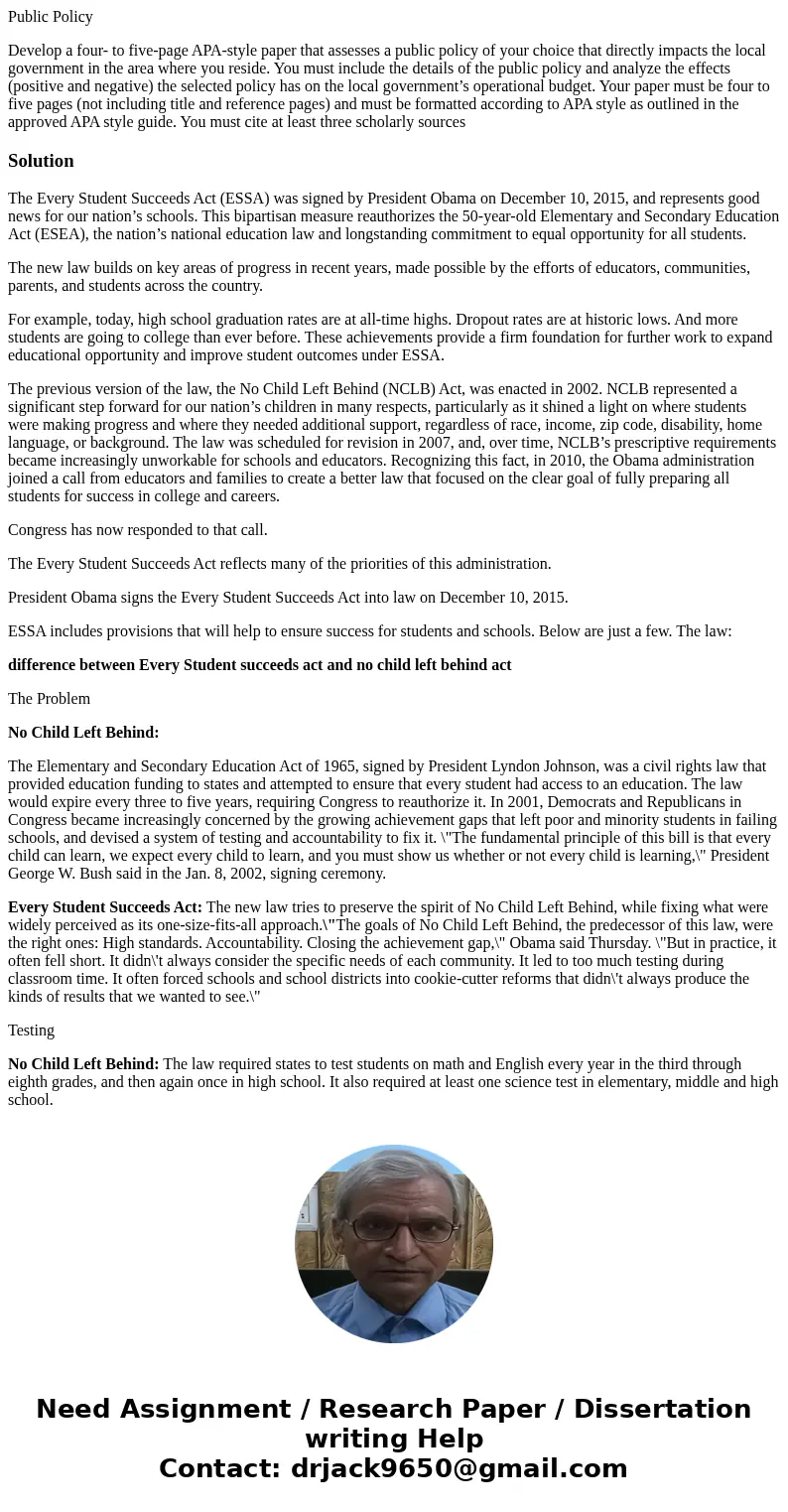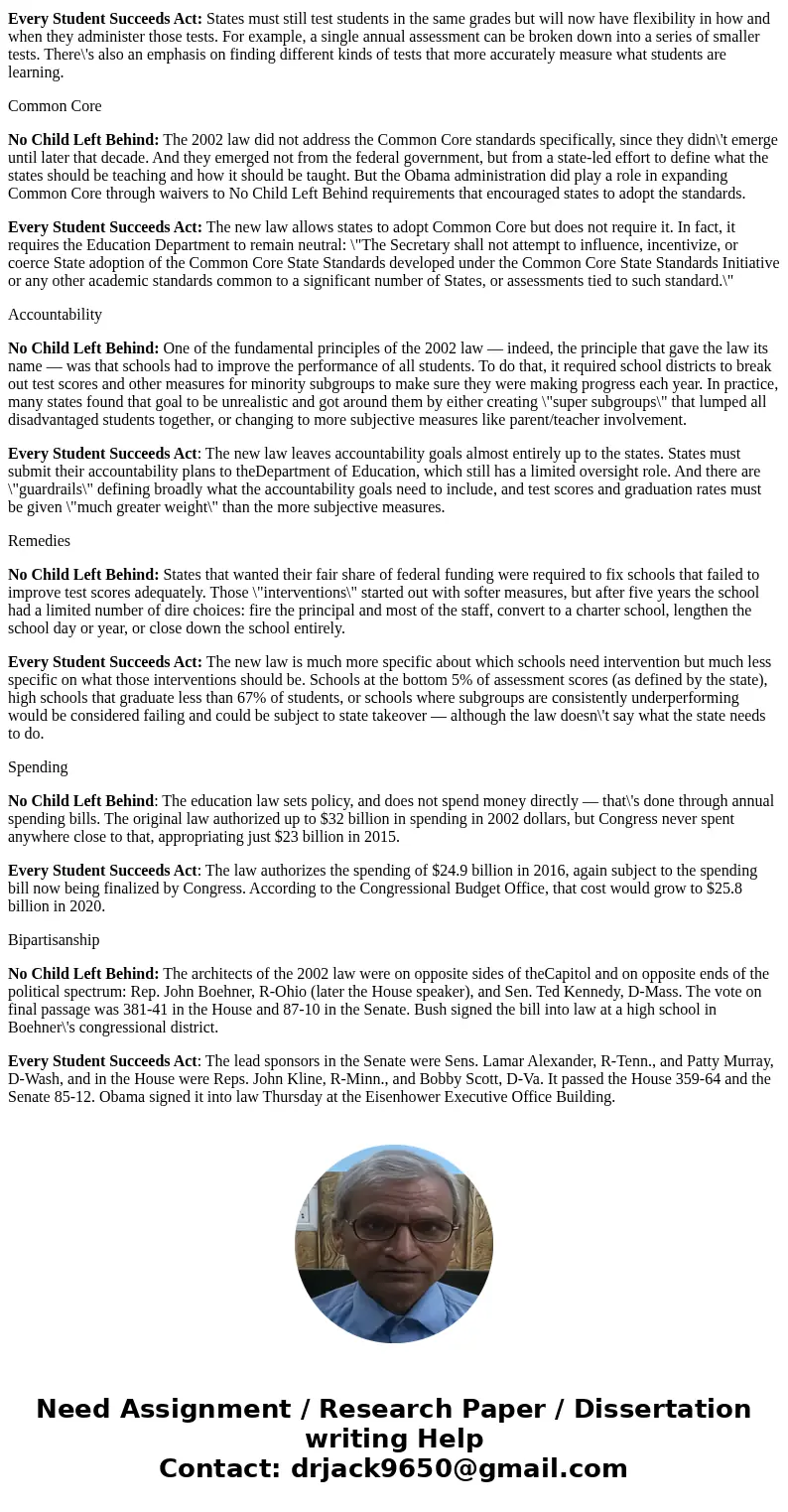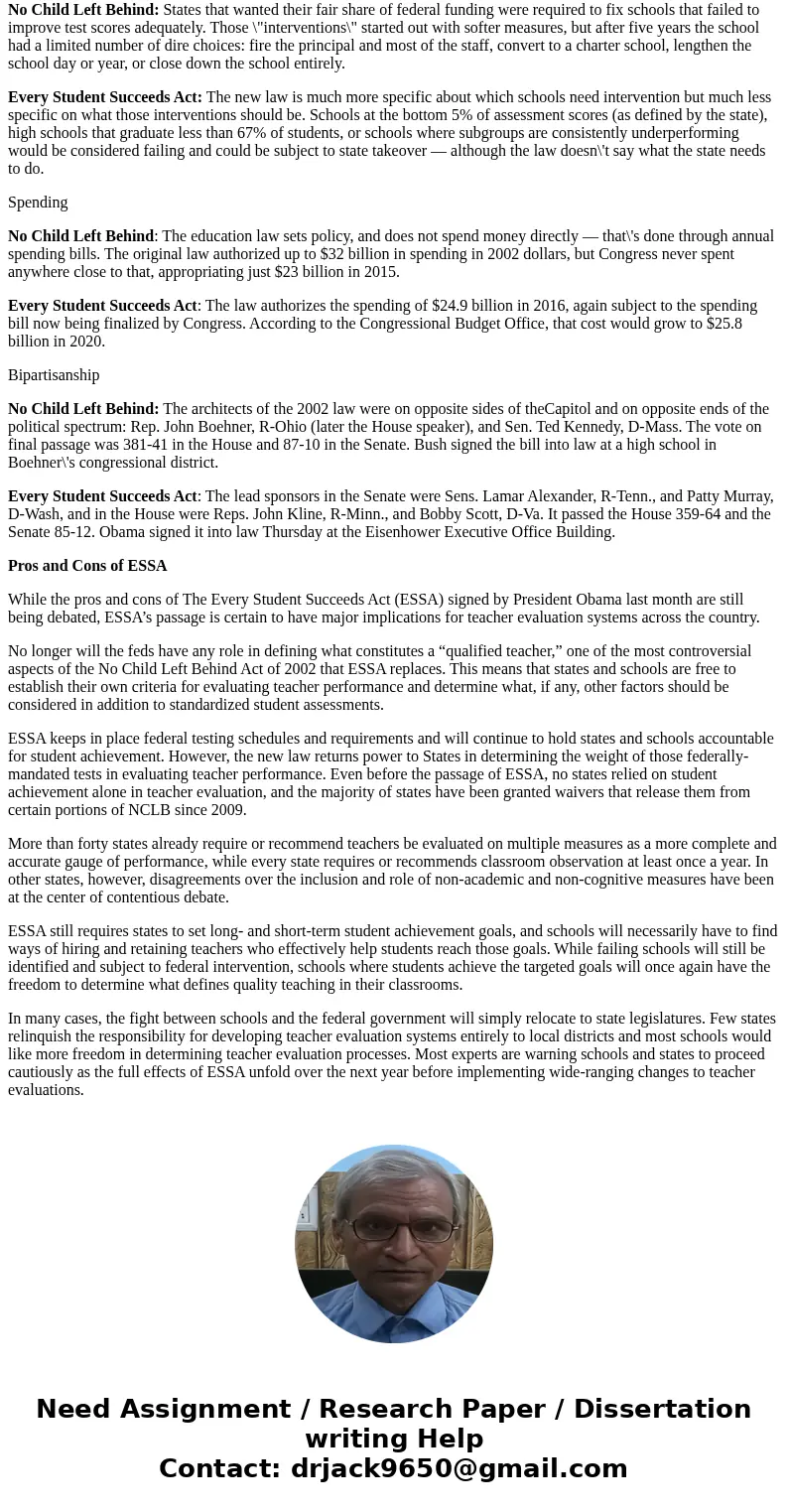Public Policy Develop a four to fivepage APAstyle paper that
Public Policy
Develop a four- to five-page APA-style paper that assesses a public policy of your choice that directly impacts the local government in the area where you reside. You must include the details of the public policy and analyze the effects (positive and negative) the selected policy has on the local government’s operational budget. Your paper must be four to five pages (not including title and reference pages) and must be formatted according to APA style as outlined in the approved APA style guide. You must cite at least three scholarly sources
Solution
The Every Student Succeeds Act (ESSA) was signed by President Obama on December 10, 2015, and represents good news for our nation’s schools. This bipartisan measure reauthorizes the 50-year-old Elementary and Secondary Education Act (ESEA), the nation’s national education law and longstanding commitment to equal opportunity for all students.
The new law builds on key areas of progress in recent years, made possible by the efforts of educators, communities, parents, and students across the country.
For example, today, high school graduation rates are at all-time highs. Dropout rates are at historic lows. And more students are going to college than ever before. These achievements provide a firm foundation for further work to expand educational opportunity and improve student outcomes under ESSA.
The previous version of the law, the No Child Left Behind (NCLB) Act, was enacted in 2002. NCLB represented a significant step forward for our nation’s children in many respects, particularly as it shined a light on where students were making progress and where they needed additional support, regardless of race, income, zip code, disability, home language, or background. The law was scheduled for revision in 2007, and, over time, NCLB’s prescriptive requirements became increasingly unworkable for schools and educators. Recognizing this fact, in 2010, the Obama administration joined a call from educators and families to create a better law that focused on the clear goal of fully preparing all students for success in college and careers.
Congress has now responded to that call.
The Every Student Succeeds Act reflects many of the priorities of this administration.
President Obama signs the Every Student Succeeds Act into law on December 10, 2015.
ESSA includes provisions that will help to ensure success for students and schools. Below are just a few. The law:
difference between Every Student succeeds act and no child left behind act
The Problem
No Child Left Behind:
The Elementary and Secondary Education Act of 1965, signed by President Lyndon Johnson, was a civil rights law that provided education funding to states and attempted to ensure that every student had access to an education. The law would expire every three to five years, requiring Congress to reauthorize it. In 2001, Democrats and Republicans in Congress became increasingly concerned by the growing achievement gaps that left poor and minority students in failing schools, and devised a system of testing and accountability to fix it. \"The fundamental principle of this bill is that every child can learn, we expect every child to learn, and you must show us whether or not every child is learning,\" President George W. Bush said in the Jan. 8, 2002, signing ceremony.
Every Student Succeeds Act: The new law tries to preserve the spirit of No Child Left Behind, while fixing what were widely perceived as its one-size-fits-all approach.\"The goals of No Child Left Behind, the predecessor of this law, were the right ones: High standards. Accountability. Closing the achievement gap,\" Obama said Thursday. \"But in practice, it often fell short. It didn\'t always consider the specific needs of each community. It led to too much testing during classroom time. It often forced schools and school districts into cookie-cutter reforms that didn\'t always produce the kinds of results that we wanted to see.\"
Testing
No Child Left Behind: The law required states to test students on math and English every year in the third through eighth grades, and then again once in high school. It also required at least one science test in elementary, middle and high school.
Every Student Succeeds Act: States must still test students in the same grades but will now have flexibility in how and when they administer those tests. For example, a single annual assessment can be broken down into a series of smaller tests. There\'s also an emphasis on finding different kinds of tests that more accurately measure what students are learning.
Common Core
No Child Left Behind: The 2002 law did not address the Common Core standards specifically, since they didn\'t emerge until later that decade. And they emerged not from the federal government, but from a state-led effort to define what the states should be teaching and how it should be taught. But the Obama administration did play a role in expanding Common Core through waivers to No Child Left Behind requirements that encouraged states to adopt the standards.
Every Student Succeeds Act: The new law allows states to adopt Common Core but does not require it. In fact, it requires the Education Department to remain neutral: \"The Secretary shall not attempt to influence, incentivize, or coerce State adoption of the Common Core State Standards developed under the Common Core State Standards Initiative or any other academic standards common to a significant number of States, or assessments tied to such standard.\"
Accountability
No Child Left Behind: One of the fundamental principles of the 2002 law — indeed, the principle that gave the law its name — was that schools had to improve the performance of all students. To do that, it required school districts to break out test scores and other measures for minority subgroups to make sure they were making progress each year. In practice, many states found that goal to be unrealistic and got around them by either creating \"super subgroups\" that lumped all disadvantaged students together, or changing to more subjective measures like parent/teacher involvement.
Every Student Succeeds Act: The new law leaves accountability goals almost entirely up to the states. States must submit their accountability plans to theDepartment of Education, which still has a limited oversight role. And there are \"guardrails\" defining broadly what the accountability goals need to include, and test scores and graduation rates must be given \"much greater weight\" than the more subjective measures.
Remedies
No Child Left Behind: States that wanted their fair share of federal funding were required to fix schools that failed to improve test scores adequately. Those \"interventions\" started out with softer measures, but after five years the school had a limited number of dire choices: fire the principal and most of the staff, convert to a charter school, lengthen the school day or year, or close down the school entirely.
Every Student Succeeds Act: The new law is much more specific about which schools need intervention but much less specific on what those interventions should be. Schools at the bottom 5% of assessment scores (as defined by the state), high schools that graduate less than 67% of students, or schools where subgroups are consistently underperforming would be considered failing and could be subject to state takeover — although the law doesn\'t say what the state needs to do.
Spending
No Child Left Behind: The education law sets policy, and does not spend money directly — that\'s done through annual spending bills. The original law authorized up to $32 billion in spending in 2002 dollars, but Congress never spent anywhere close to that, appropriating just $23 billion in 2015.
Every Student Succeeds Act: The law authorizes the spending of $24.9 billion in 2016, again subject to the spending bill now being finalized by Congress. According to the Congressional Budget Office, that cost would grow to $25.8 billion in 2020.
Bipartisanship
No Child Left Behind: The architects of the 2002 law were on opposite sides of theCapitol and on opposite ends of the political spectrum: Rep. John Boehner, R-Ohio (later the House speaker), and Sen. Ted Kennedy, D-Mass. The vote on final passage was 381-41 in the House and 87-10 in the Senate. Bush signed the bill into law at a high school in Boehner\'s congressional district.
Every Student Succeeds Act: The lead sponsors in the Senate were Sens. Lamar Alexander, R-Tenn., and Patty Murray, D-Wash, and in the House were Reps. John Kline, R-Minn., and Bobby Scott, D-Va. It passed the House 359-64 and the Senate 85-12. Obama signed it into law Thursday at the Eisenhower Executive Office Building.
Pros and Cons of ESSA
While the pros and cons of The Every Student Succeeds Act (ESSA) signed by President Obama last month are still being debated, ESSA’s passage is certain to have major implications for teacher evaluation systems across the country.
No longer will the feds have any role in defining what constitutes a “qualified teacher,” one of the most controversial aspects of the No Child Left Behind Act of 2002 that ESSA replaces. This means that states and schools are free to establish their own criteria for evaluating teacher performance and determine what, if any, other factors should be considered in addition to standardized student assessments.
ESSA keeps in place federal testing schedules and requirements and will continue to hold states and schools accountable for student achievement. However, the new law returns power to States in determining the weight of those federally-mandated tests in evaluating teacher performance. Even before the passage of ESSA, no states relied on student achievement alone in teacher evaluation, and the majority of states have been granted waivers that release them from certain portions of NCLB since 2009.
More than forty states already require or recommend teachers be evaluated on multiple measures as a more complete and accurate gauge of performance, while every state requires or recommends classroom observation at least once a year. In other states, however, disagreements over the inclusion and role of non-academic and non-cognitive measures have been at the center of contentious debate.
ESSA still requires states to set long- and short-term student achievement goals, and schools will necessarily have to find ways of hiring and retaining teachers who effectively help students reach those goals. While failing schools will still be identified and subject to federal intervention, schools where students achieve the targeted goals will once again have the freedom to determine what defines quality teaching in their classrooms.
In many cases, the fight between schools and the federal government will simply relocate to state legislatures. Few states relinquish the responsibility for developing teacher evaluation systems entirely to local districts and most schools would like more freedom in determining teacher evaluation processes. Most experts are warning schools and states to proceed cautiously as the full effects of ESSA unfold over the next year before implementing wide-ranging changes to teacher evaluations.



 Homework Sourse
Homework Sourse